Electric bike batteries are a complex subject. When selecting one, numerous questions arise: 36 V or 48 V? Lithium, lead, or nickel? Wattage? Amp-hour? Which brands are truly reliable? Explore our comprehensive guide to electric bike batteries, simplifying the selection process.
The Best Electric Bike Batteries
36V Electric Bike Batteries
Below you’ll find our selection of 36V electric bike batteries. These batteries are suitable for a wide variety of electric bikes and offer a blend of durability, efficiency, and power that enhances your commuting experience, whether it’s a daily ride or a long journey.
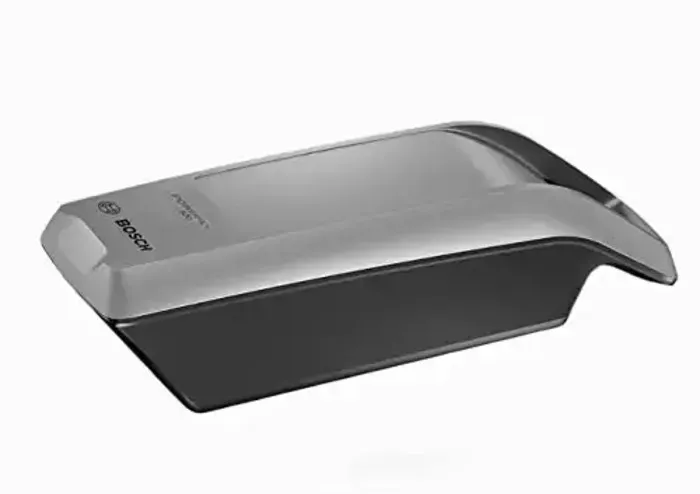
Bosch Powerpack 500Wh Platinum
Suitable for frames and racks, overload protection, 6.17 lbs. Compatible with Powerpack 300 and 400 e-bikes.
Type : Lithium | Voltage: 36 V | Range: 13.4 Ah | Power: 500 Wh
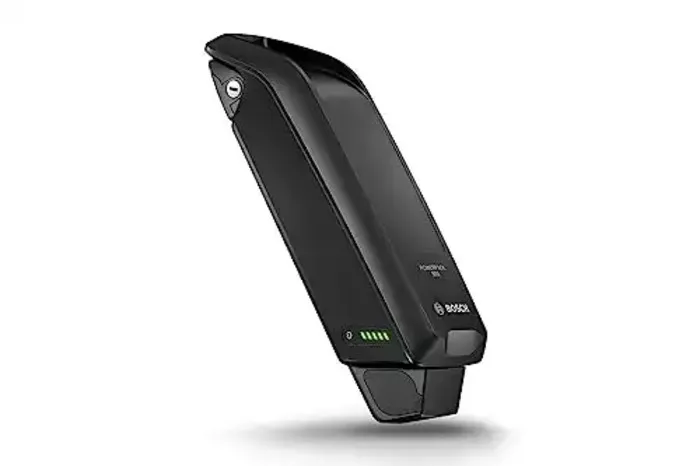
Bosch Powerpack 500Wh Anthracite
Frame or luggage rack compatible, high-performance, overheat-proof, splash-proof. 2-year warranty.
Type : Lithium | Voltage: 36 V | Range: 13.4 Ah | Power: 500 Wh
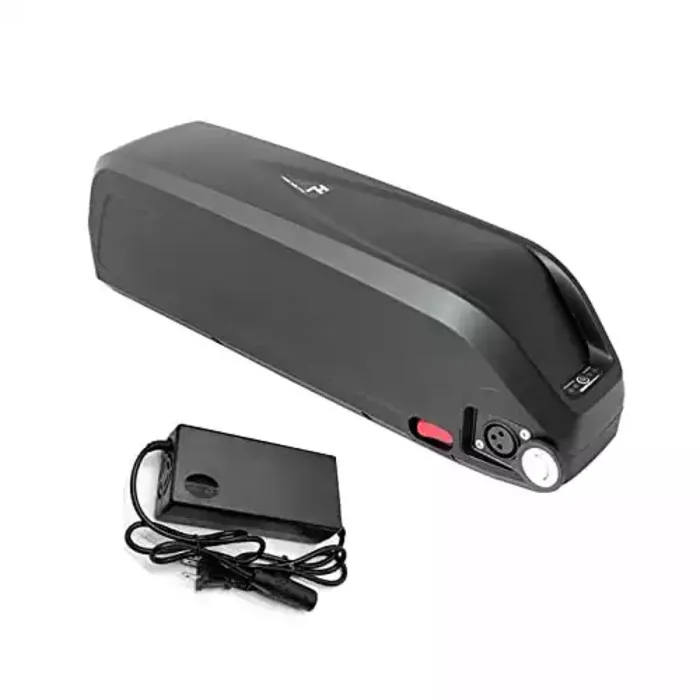
SDTYYP battery
Supplied with quick charger, mounting plate to fit all bikes, classic black design.
Type : Lithium | Voltage: 36 V | Range: 10 Ah | Power: 624 Wh

SEASON E-Bike 15Ah
Easy to carry with the handle, waterproof, compatible with 250W to 500W motors. 18-month warranty.
Type : Lithium | Voltage: 36 V | Range: 15 Ah | Power: 555 Wh
48V Electric Bike Batteries
If you’re aiming to maximize the performance and distance of your electric bike trips, a 48V battery might be exactly what you’re looking for. These batteries provide superior energy capacity, resulting in higher speeds and longer range.

Season battery
Compatible with 250W motors, mounts on frame or carrier, weighs 8.15 lbs, fully charged in 6 hours. 2-year warranty.
Type : Lithium | Voltage: 48 V | Range: 13 Ah | Power: 462 Wh
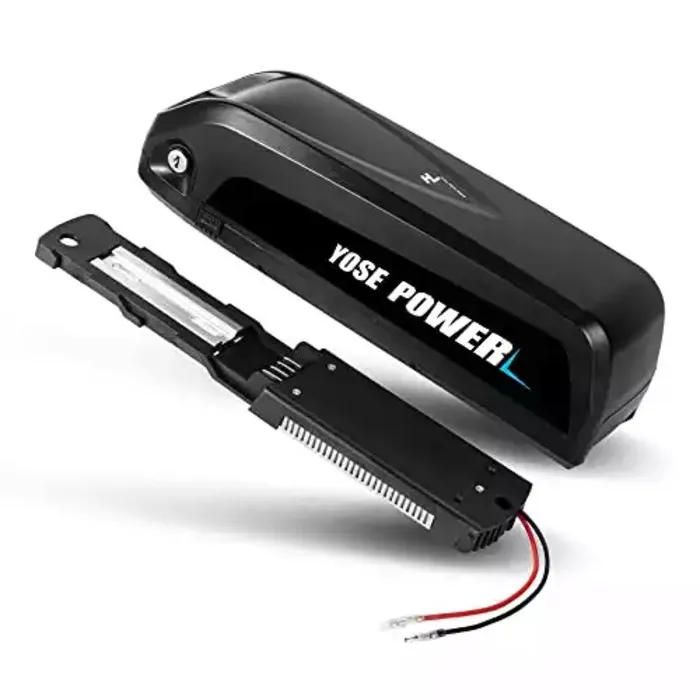
Yose power
Ideal for 250W to 900W motors. Supplied with 4-pin discharge port, lock and charge level indicator. 18-month warranty.
Type : Lithium | Voltage: 48 V | Range: 13 Ah | Power: 625 Wh

Unit pack power U004
Frame battery, very long range, shockproof. 5-year service life. Compatible with motors from 50W to 1800W.
Type : Lithium | Voltage: 48 V | Range: 24 Ah | Power: 1152Wh
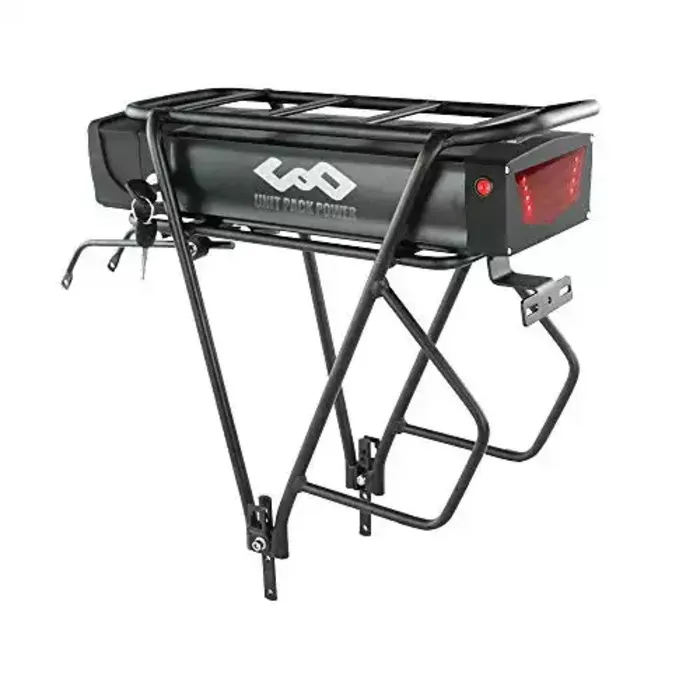
Unit Pack power for luggage rack
Battery designed for luggage racks, suitable for motors from 50W to 1000W. Ideal for Bafang motors. Lock, charge indicator and USB port.
Type : Lithium | Voltage: 48 V | Range: 20 Ah | Power: 1000Wh
How to Choose Your Electric Bike Battery?
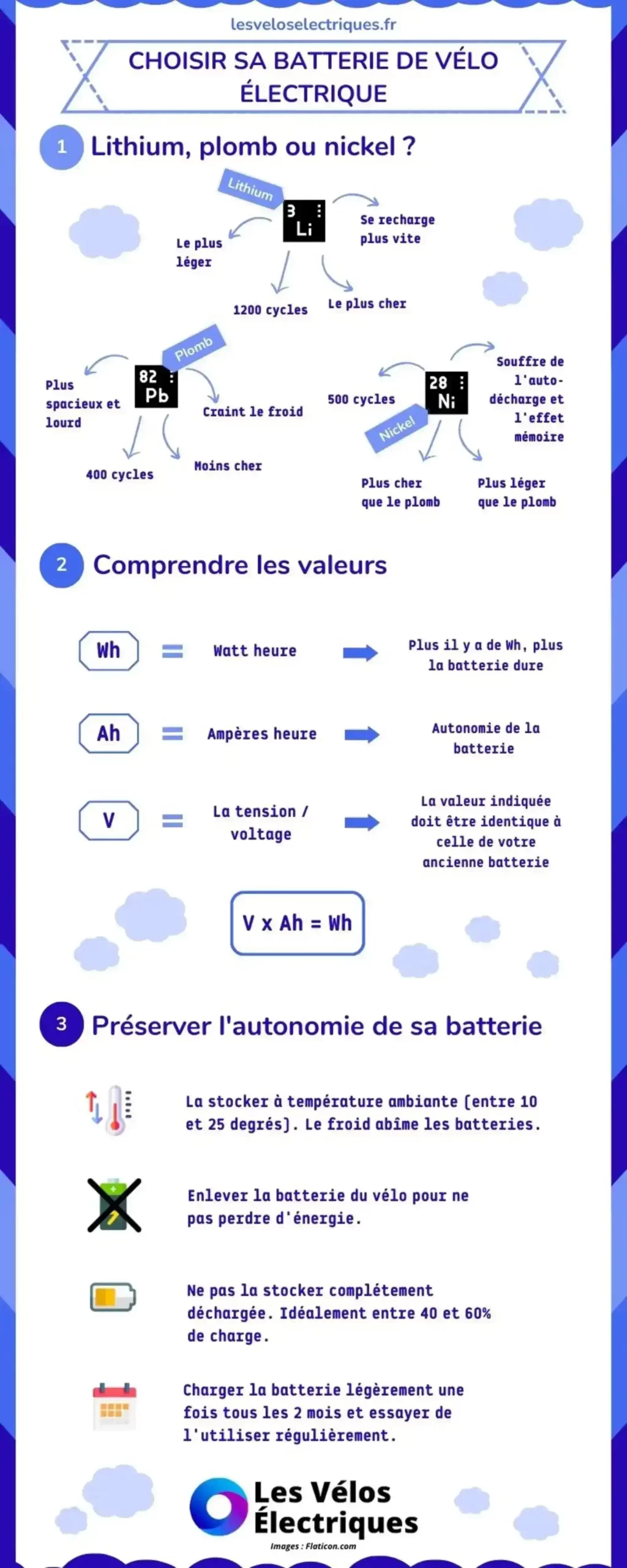
Here are the key (technical) considerations when replacing your electric bike battery.
- Which type of battery should I choose: lithium, lead-acid, or nickel?
- What power rating in Watts should I consider?
- Which voltage is preferable: 36 V or 48 V?
- What capacity in Ah (Ampere-hours) is recommended?
- What range and efficiency can I expect?
- Which brands offer the best bicycle batteries?
Which Type of Battery Should I Choose: Lithium, Lead-Acid, or Nickel?
Electric bike batteries come in various types, each with unique characteristics in terms of lifespan (number of cycles), weight, and performance. Here’s a guide to help you choose:
Lead-Acid Batteries (400 Cycles)
Lead-acid batteries are the most affordable option and have an advantage of being highly resistant to the memory effect. This means they maintain performance even if recharged before being fully discharged. However, lead-acid batteries are sensitive to cold temperatures, bulkier, and heavier.
Nickel-Metal Hydrid (Ni-Mh) Batteries (500 Cycles)
Nickel-metal hydride (Ni-Mh) batteries are lighter than lead-acid batteries but still suffer from the memory effect and self-discharge. Although they offer more power than lead-acid batteries, their limited lifespan is causing them to be replaced by lithium batteries.
Lithium Batteries (1200 Cycles)
Lithium batteries are the market leader due to their efficiency. Weighing between 4 to 6 lbs, lithium batteries offer a superior weight-to-performance ratio compared to lead-acid batteries. This proven technology, also used in smartphones and laptops, boasts the longest service life (between 700 and 1,200 charge/discharge cycles).
Lithium batteries can achieve an efficiency of up to 90%, meaning for every 100 Wh of electricity input, 90 Wh are stored. Within lithium batteries, LiFePO4 (lithium iron phosphate) is becoming increasingly popular. Here are three reasons for its rise in popularity:
- Long lifespan: over 3,000 charge/discharge cycles.
- High level of safety: virtually no risk of fire or explosion.
- Environmental benefits: lithium iron phosphate is non-toxic.
The only drawback is that the energy density of a LiFePO4 battery remains lower than that of a lithium-ion battery, resulting in heavier weight for the same power output.
Looking ahead, sodium (Na) is emerging as a less scarce alternative to lithium. Amiens-based start-up Tiamat, which recently raised 3.6 million euros, has developed Na-ion cells optimized for 4,000 charge/discharge cycles and ultra-fast recharge times measured in minutes. Successfully tested on a scooter, sodium batteries could be used in electric bicycles within the next 2 or 3 years.

Watts, Ah, Volts: Understanding Battery Specifications
Electric bike batteries vary in energy storage capacity. This capacity, expressed in Wh, is calculated by multiplying the voltage (typically 36 V) by the battery capacity (Ah). Power is measured in Watts and correlates with range. For most electric bikes, power should not exceed 250 W. Riders of high-performance electric bikes may consider batteries ranging from 400 Wh to 500 Wh. Key takeaways include:
- A higher Wh rating in your electric bike battery means longer-lasting performance. A 500 Wh battery will last twice as long as a 250 Wh battery.
- Higher Ah (Ampere-hour) values translate to longer ranges.
- Select a battery model with the same voltage as your current battery (typically 24 V, 36 V, or 48 V).
Choosing the Right Voltage for Your Electric Bike Battery: 36 V or 48 V?
The primary distinction between 36V and 48V electric bike batteries lies in their nominal voltage and energy capacity, both of which impact the bike’s performance and range.
- 36V Battery: This voltage is standard for many electric bikes, particularly those designed for daily or urban commuting. A 36V battery typically provides good range and is ideal for riders covering moderate distances at comfortable speeds.
- 48V Battery: A 48V battery boasts higher voltage, resulting in greater energy capacity and power output. It allows for higher speeds and extended range, making it perfect for riders covering longer distances or tackling challenging terrains, such as mountain or off-road trails.
Note that the battery must be compatible with the electric bike’s motor. Swapping a 36V battery for a 48V one isn’t always feasible without considering the motor’s specifications. Additionally, 48V batteries tend to be more expensive due to their increased energy capacity.
Best Electric Bike Battery Brands
Finding the best electric bike battery brand can be challenging due to the vast array of options. Avoid falling for abnormally low prices, as quality cells come at a cost. Instead, trust reputable battery brands like Bosch with its renowned Powerpack, LG, Bafang, X-Go, Green Cell Pro, CYCBT, HalloMotor, Panasonic, Yamaha, and more.
Installation Location

While the battery’s location won’t affect speed, it can influence bike behavior and rider comfort. For instance, for a sporty feel or when using a rear wheel motor (for balance), avoid placing the battery on the rack or at the rear of the seat tube.
Choose batteries with specific geometries designed to fit various frame types. The ideal location is one that adds stiffness to the frame without compromising balance or agility, while protecting the battery from shocks. Consider bike-specific constraints; for example, on full-suspension bikes, the bottle cage may not accommodate the battery.
Ease of Installation
Replacing your battery with an equivalent model is straightforward. However, switching to an oversized battery or a different technology (e.g., from NiMh to lithium) may require some skill and patience. Tasks like installing new supports, preparing wiring, or soldering wires to terminals are more DIY than routine maintenance. Ensure your charger is compatible with the new battery.
How to Extend Electric Bike Battery Life
Tips for Preserving Electric Bike Battery Life:
- Store your battery at room temperature (10-25 degrees Celsius). Cold temperatures reduce voltage and disrupt chemical reactions that produce energy.
- Remove the battery from the bike when not in use to prevent energy drain.
- Avoid storing the battery completely discharged; aim for 40-60% charge when storing long-term.
- Charge the battery lightly at least once every 2 months to maintain health.
- Regular use helps keep the battery in good condition.
However, two identical batteries stored under similar conditions may not yield identical performance. Battery performance is also influenced by factors such as the rider’s weight, riding habits, and the bike’s specifications, for instance:
- Rider’s weight;
- His pedaling frequency;
- The course profile (number and steepness of hills, wind strength, type of surface…) ;
- Number of stops and restarts;
- Tire pressure;
- Presence of a device connected in USB on the battery…
Can You Charge an Electric Bike Battery While Riding?
Unfortunately, not at the moment. It’s not currently possible to regain autonomy by coasting downhill or pedaling backwards. However, this feature may become available in the coming years for electric bikes.
Certain manufacturers, like ThirtyOne and Sanyo, are actively addressing this challenge. However, the current increase in range is minimal. The BionX system can recover energy, but activating the regenerative mode manually provides only a modest increase in recharge capacity.
Nonetheless, innovation thrives where there’s demand, and we’re optimistic that R&D teams at specialized companies will deliver more efficient solutions soon. Meanwhile, the only option is to recharge using a 220 V mains power supply.
Tip: Opt for a Durable Battery
Here’s a helpful tip! When purchasing a battery for your electric bike, check its manufacturing date. Batteries stored for 2 or 3 years in warehouses or on shelves may have lost some capacity and are not worth purchasing, even if on sale. Even if discounted, it’s not worth the investment. You may end up needing to replace it prematurely.
Additionally, a good casing is essential for preserving your battery. This is particularly crucial if you plan to install it on a rugged electric mountain bike. The casing must offer effective waterproof protection against dust. An IP54 rating (IEC 60529 standard) provides reassurance by ensuring protection against dust (rating 5) and water splashes from all directions (rating 4).
To estimate battery life, we consider the number of charge/discharge cycles. Choosing models with a higher number of cycles is advisable. However, this number serves as an indication and depends on how you store and use the battery.
What Are Electric Bike Batteries Made of?
- Cells assembled together, known as accumulators, are responsible for storing energy.
- The battery is encased in a sealed resin assembly that protects it from shocks.
- Wiring
- A motherboard, or battery management system, intelligently manages and regulates power assistance.
What About Battery Recycling?
Electric bike batteries are typically guaranteed for between 6 months and 2 years. After this period, when the battery reaches the end of its life, the question is: where to dispose of this bulky waste?
Spoiler alert: not in the yellow garbage can. And certainly not in the neighbor’s composter, neither seen nor known #THUGLIFE !!! But you can get rid of it very easily, either :
- Take it to a recycling center that has designated bins for battery disposal.
- Take it to an electric bike dealer, as they are obligated to collect used batteries.
- Consider a specialized company that reconditions batteries, replacing tired cells to extend battery life.
- Finally, some specialists offer to buy back your old battery!
There are numerous collection points, and battery recycling processes are becoming more efficient. An estimated 90% of lead-acid battery cells can be reused. However, for lithium batteries, reliable recycling figures are currently unavailable despite their longer lifespan. Recycling is complex due to the presence of metals like cobalt, manganese, and nickel.
Research is advancing, improving our ability to repurpose used batteries. This is critical, especially considering Tesla’s ambitions. The electric car manufacturer has constructed no fewer than 3 Gigafactories to supply batteries for up to half a million vehicles annually… Let’s envision a future with 100% recyclable batteries with these advancements!
Our Top Picks for Electric Bike Batteries
36V Electric Bike Batteries

SEASON E-Bike 15Ah
Easy to carry with the handle, waterproof, compatible with 250W to 500W motors. 18-month warranty.
Type : Lithium | Voltage: 36 V | Range: 15 Ah | Power: 555 Wh

Bosch Powerpack 500Wh Platinum
Suitable for frames and racks, overload protection, 6.17 lbs. Compatible with Powerpack 300 and 400 e-bikes.
Type : Lithium | Voltage: 36 V | Range: 13.4 Ah | Power: 500 Wh

Bosch Powerpack 500Wh Anthracite
Frame or luggage rack compatible, high-performance, overheat-proof, splash-proof. 2-year warranty.
Type : Lithium | Voltage: 36 V | Range: 13.4 Ah | Power: 500 Wh

SDTYYP battery
Supplied with quick charger, mounting plate to fit all bikes, classic black design.
Type : Lithium | Voltage: 36 V | Range: 10 Ah | Power: 624 Wh
48V Electric Bike Batteries

Season battery
Compatible with 250W motors, mounts on frame or carrier, weighs 8.15 lbs, fully charged in 6 hours. 2-year warranty.
Type : Lithium | Voltage: 48 V | Range: 13 Ah | Power: 462 Wh

Yose power
Ideal for 250W to 900W motors. Supplied with 4-pin discharge port, lock and charge level indicator. 18-month warranty.
Type : Lithium | Voltage: 48 V | Range: 13 Ah | Power: 625 Wh

Unit pack power U004
Frame battery, very long range, shockproof. 5-year service life. Compatible with motors from 50W to 1800W.
Type : Lithium | Voltage: 48 V | Range: 24 Ah | Power: 1152Wh

Unit Pack power for luggage rack
Battery designed for luggage racks, suitable for motors from 50W to 1000W. Ideal for Bafang motors. Lock, charge indicator and USB port.
Type : Lithium | Voltage: 48 V | Range: 20 Ah | Power: 1000Wh

